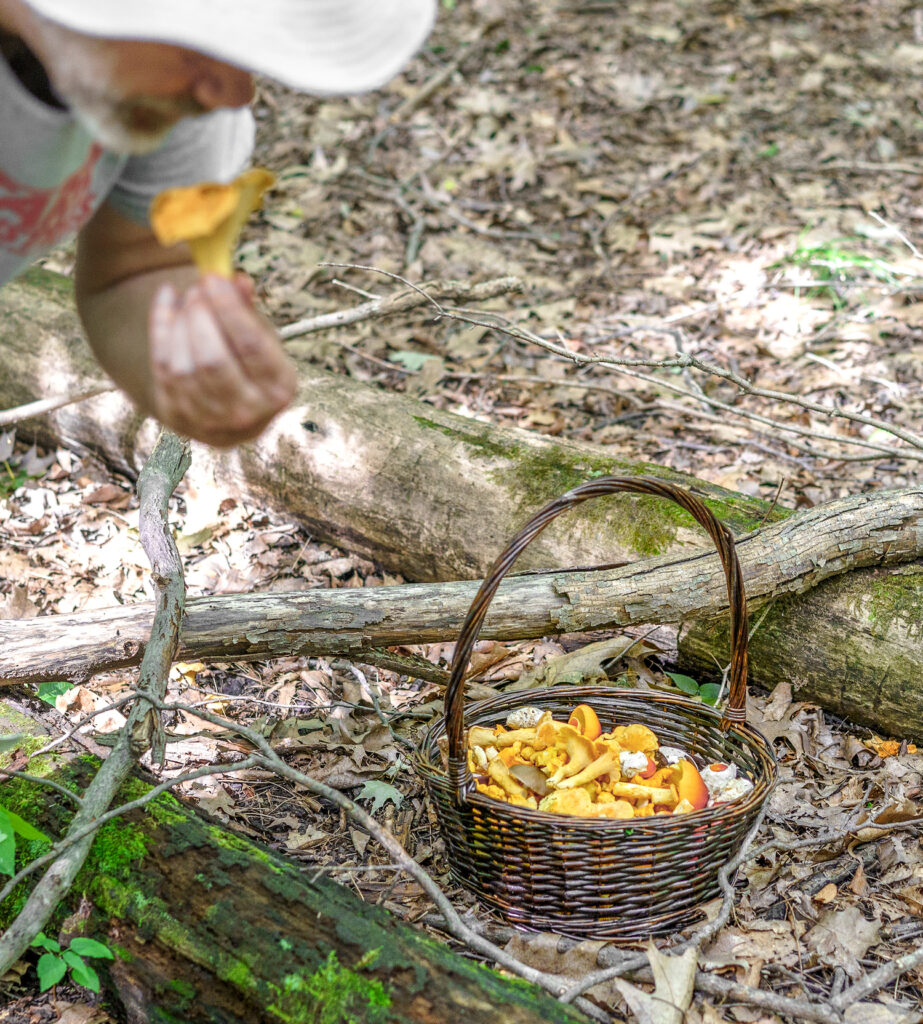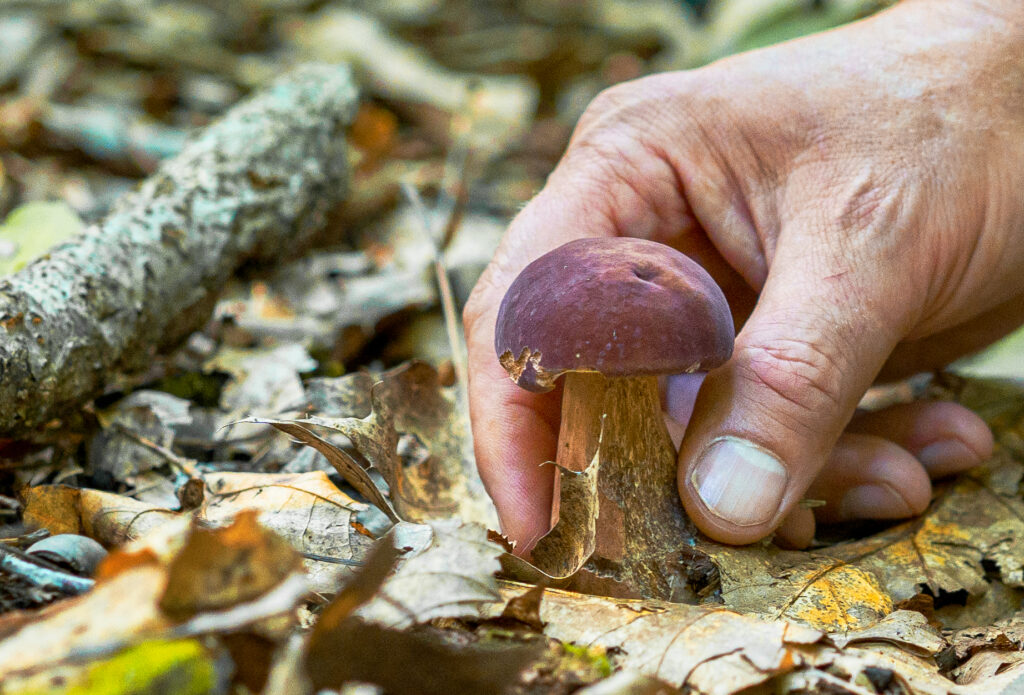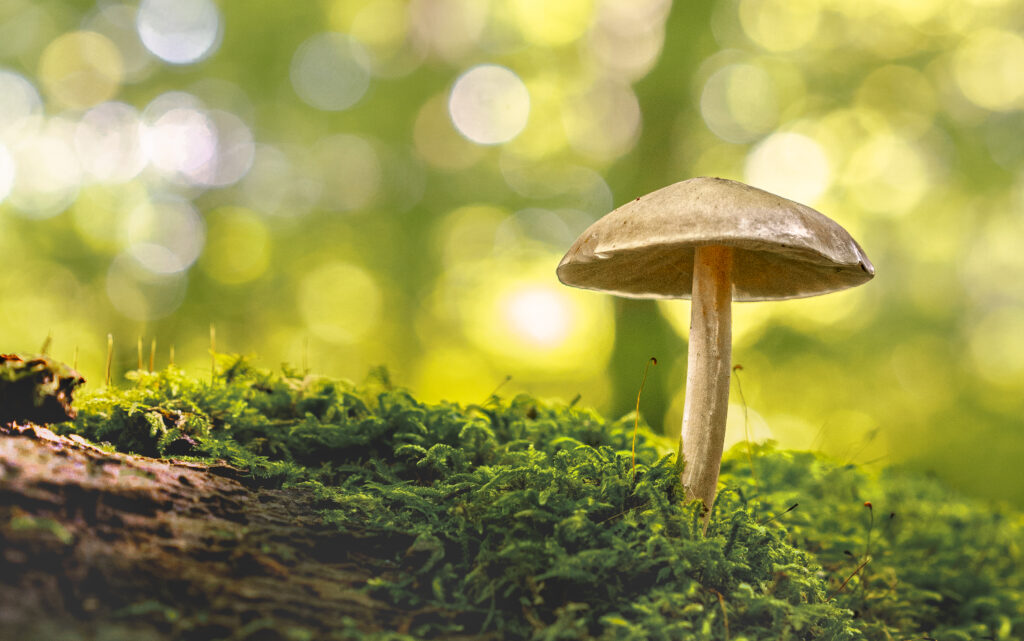It was the last Monday of July at West Branch State Park, a few days after a soaking rain.
The late-afternoon air was humid, and the sun shone through the dense treetops, casting patches of light on the forest floor where local mushroom hunting guide and award-winning chef Don King foraged for his favorite species of edible and medicinal fungi.
Several species of mushrooms were in bloom and ready for harvest. It wasn’t long before a bonanza of orange chanterelles were nestled in King’s wicker basket, along with a few other varieties.
King, a local fixture known as The Mushroom Hunter on Facebook, has been interested in mushrooming for over 15 years. His full-time job is teaching digital media at Kent State, but he somehow finds time to share his vast mycological knowledge through local guided tours and his YouYube channel. He has conducted events at the Cleveland Metroparks; the Holden Arboretum in Kirtland, Ohio; and The Wilderness Center in Wilmot, Ohio. He also extends his expertise to library patrons through presentations and mushrooming forays.

His hobby of foraging for fungi began as the result of his fascination with the “dozens” of varieties of mushrooms that were popping up in his yard. He was convinced that some of the fungi growing beyond his front door were edible, so he began to study mycology from books and on the internet to find out “about the different mushrooms, and how and where they grow,” he said.
King admits he jumped in slowly, spending a considerable amount of time learning to identify each species so that he could determine which ones were toxic or even deadly. Eventually, he became confident in his ability to pick out the palatable ones.
“The first couple of mushrooms I ate were actually from our yard,” King said. “I identified an edible puffball, a couple of other edible mushrooms, and then I started slowly working my way into other species that were pretty safe, like morels, and things like that. It started very slowly. It took me several years to build up to the point where I knew a couple of species for sure, you know.”
There are over 2,000 species of wild mushrooms in Ohio, many of which are edible. They grow in a sundry of locations throughout a forest for reasons that are specific to the species. Some grow on rotting logs to aid in the composting process; others fruit among fallen pine needles to help supplement the soil with additional nutrients. The life cycle of fungi can vary greatly depending on the species.
“It’s pretty fascinating the different habitats and the different times of year and everything that needs to come together for them to work,” King said. “Some can live for a month, others a year, some can grow year-round. Then we have perennial mushrooms that grow year after year, and get bigger and bigger. We have some that grow up in the morning and die by the afternoon, then we have ones that are decades old.”
Around 1993, in Crystal Falls, Michigan, researchers discovered an Armillaria gallica mushroom that weighed 220,000 pounds, spanned about 91 acres and was estimated to be up to 2,500 years old. Much of the mushroom consists of a profusion of mycelium, or tendrils, growing beneath the ground, which occasionally sends honey mushrooms to the surface. Another Armillaria growing in Oregon’s Blue Mountains is said to be 8,000 years old, spanning a whopping three square miles.

For newcomers to mushroom gathering, there are a wealth of species to be found in Ohio, but first things first: For beginners, King says a mushroom field guide is important to study for identifying edible mushrooms and their toxic lookalikes. But he also believes that referring to outside sources to get a second opinion is helpful.
“When I was starting out, I totally had the field guide with me all the time,” King said, “and I highly recommend that for beginners. The one field guide I have right now and is my favorite is a fairly large book (“Appalachian Mushrooms” by Walter Sturgeon). It’s not a pocket guide. I leave it in my car. If I find something interesting or something I don’t know, I’ll bring it back and ID it there. Or when I’m out in the woods, I’ll take good photos and post it directly to some of these mushroom identification sites on Facebook, and generally within five or 10 minutes, I’m starting to get some ideas about what it is, and then I can compare from there as well.
“I know what I’m looking for, generally, and what’s good and what’s not; not to say I don’t have more to learn, that’s certainly not the case.”
After joining several Facebook mushroom identification groups, King said his knowledge of fungi really began to expand.
“I could just see post after post, photo after photo,” King said, “all these identifications given by the experts. A lot of the people who write these field guides are in these mushroom groups on Facebook. I started comparing what I was seeing there with what I was seeing here [in the forest] and in my field guide, and I got more field guides and more experience, and it kinda took off from there. There’s so much variety of plants and fungi here [In Ohio].”
Besides acquiring mushroom ID books and becoming a member of Facebook groups, there are a few other things that King says new mushroomers should do. For starters, get a can of OFF! Deep Woods bug spray, and get some long pants or socks to protect against poison ivy, poison oak, thorns, stickers and the like. A curved mushroom knife with a brush on the end for cleaning dirt from gathered mushrooms is also useful. And then you’ll need something to put your mushrooms in when you find them.
“I go out with a [wicker] basket and a mushroom knife,” King said. “Carrying them around in an open basket, they can breathe. Sometimes, in bags, more delicate mushrooms can get crushed up a lot easier. When putting mushrooms in bags, especially if it’s hot and humid, they can get kinda mushy, they start to sweat, they start to release their moisture, and they can get kinda weird. Sometimes I forget both, or I just stop on a whim and I just pile them in my shirt or carry them around in a Taco Bell bag I find in the back seat or something.”
In addition to the benefit of a wicker basket’s protection and breathability, the spaces between the warp and weft of the wicker allow the spores on the fungi to escape and disperse throughout the forest to grow new mushrooms.
After acquiring the tools needed for mushrooming, King says to dive into the hobby slowly. “Learn hands-on, or if you can, learn from somebody who knows what they’re doing,” he said.
“In the spring, learn what a morel looks like,” King said. “Just that one mushroom. There are a couple species with several different colors, but they all have the same characteristics. Don’t get overwhelmed with the 50 other mushrooms that you might see out there; home in on one thing and really kind of learn that, and then move on to the next thing.
“And then summer comes along and you’re not going to see morels anymore; learn what a chanterelle looks like and how to find it. Kinda keep it real simple. Learn what they are, learn their possible toxic lookalikes, if there are any. There are some really safe edible mushrooms out there because they just don’t have any toxic lookalikes, or the supposed lookalikes don’t look anything like them at all. There are mushrooms called false morels, and most of them look nothing like a morel; you would not even confuse them to begin with.”

But there’s no need to learn how to forage for fungi on your own when a guided mushrooming foray with King is only $50. With his help, you’ll have the assurance that the mushrooms you gather are safe for consumption — and tasty, too. He offers hunts at West Branch State Park in Ravenna, Punderson State Park in Newbury and Mosquito Lake State Park in Cortland.
“We go out for two-and-a-half hours,” King said, “and we go to a state park where you are allowed to harvest mushrooms. I always take people to areas that I know produce the mushrooms we’re looking for that time of year. We just kind of go out into the woods, spread out and start looking. I try to give as many identifications as possible. I give everyone a little laminated mushroom guide with maybe eight different species.”
King said his guided tours get booked fast because of the growing popularity of outdoor activities after post-Covid lockdown conditions, so make sure you book in advance.
“When it was the lockdown, nothing was open. People started fishing more, camping more, and all of a sudden they said, ‘Hey, we can do a group activity outdoors, safely, social distancing, and everything outdoors, and learn,’ and everything kinda came together for that. One of the silver linings of the pandemic is people are kinda getting back to nature and their roots and things.”
To inquire about Don King’s mushroom hunt or to sign up for his newsletter, visit his website at https://www.themushroomhunter.com/mushroom-hunts/
Follow King’s Facebook page at https://www.facebook.com/themushroomhunter

